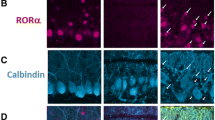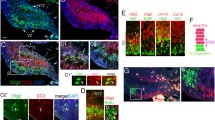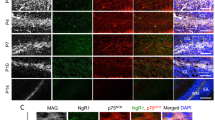Abstract
PACAP exerts neuroprotective effects during development, especially in the cerebellum where PAC1 receptor and ligand are both expressed. However, while previous studies using PACAP injections in postnatal animals defined trophic effects of exogenous peptide, the role of endogenous PACAP remains unexplored. Here, we used PAC1−/− mice to investigate the role of PACAP receptor signaling in postnatal day 7 cerebellum. There was no difference in DNA synthesis in the cerebellar EGL of PAC1−/− compared to wild type animals, assessed using thymidine incorporation and BrdU immunohistochemistry. In contrast, we found that a significant proportion of newly generated neurons were eliminated before they successfully differentiated in the granule cell layer. In aggregate, these results suggest that endogenous PACAP plays an important role in cell survival during cerebellar development, through the activation of the PAC1 receptor.





Similar content being viewed by others
Abbreviations
- BrdU:
-
bromodeoxyuridine
- EGL:
-
external germinal layer
- IGL:
-
internal granule cell layer
- MOL:
-
molecular layer
- PACAP:
-
Pituitary adenylate cyclase-activating polypeptide
- PAC1:
-
PACAP-specific receptor 1
- PAC1-/- :
-
PAC1-knockout mouse
- PBS:
-
phosphate buffer saline
- PFA:
-
paraformaldehyde
- TCA:
-
trichloroacetic acid
- Triton X100:
-
4-(1,1,3,3-Tetramethylbutyl)phenyl-polyethylene glycol
- [3H]-Thy:
-
[3H]-thymidine
References
Abad, C., Gomariz, R. P., & Waschek, J. A. (2006). Neuropeptide mimetics and antagonists in the treatment of inflammatory disease: focus on VIP and PACAP. Current Topics in Medicinal Chemistry, 6, 151–163.
Alavez, S., Blancas, S., & Morán, J. (2006). Effect of N-methyl-D-aspartate receptor blockade on caspase activation and neuronal death in the developing rat cerebellum. Neuroscience Letters, 404, 176–181.
Allais, A., Burel, D., Isaac, E. R., et al. (2007). Altered cerebellar development in mice lacking pituitary adenylate cyclase-activating polypeptide. European Journal of Neuroscience, 25, 2604–2618.
Altman, J. (1972a). Postnatal development of the cerebellar cortex in the rat. 3. Maturation of the components of the granular layer. Journal of Comparative Neurology, 145, 465–513.
Altman, J. (1972b). Postnatal development of the cerebellar cortex in the rat. I. The external germinal layer and the transitional molecular layer. Journal of Comparative Neurology, 145, 353–397.
Basille, M., Falluel-Morel, A., Vaudry, D., et al. (2006). Ontogeny of PACAP receptors in the human cerebellum: perspectives of therapeutic applications. Regulatory Peptide, 137, 27–33.
Basille, M., Vaudry, D., Coulouarn, Y., et al. (2000). Comparative distribution of pituitary adenylate cyclase-activating polypeptide (PACAP) binding sites and PACAP receptor mRNAs in the rat brain during development. Journal of Comparative Neurology, 425, 495–509.
Burke, K., Cheng, Y., Li, B., et al. (2006). Methylmercury elicits rapid inhibition of cell proliferation in the developing brain and decreases cell cycle regulator, cyclin E. Neurotoxicology, 27, 970–981.
Cameron, D. B., Galas, L., Jiang, Y., Raoult, E., Vaudry, D., & Komuro, H. (2007). Cerebellar cortical-layer-specific control of neuronal migration by pituitary adenylate cyclase-activating polypeptide. Neuroscience, 146, 697–712.
Carey, R. G., Li, B., & DiCicco-Bloom, E. (2002). Pituitary adenylate cyclase activating polypeptide anti-mitogenic signaling in cerebral cortical progenitors is regulated by p57Kip2-dependent CDK2 activity. Journal of Neuroscience, 22, 1583–1591.
Cheng, Y., Black, I. B., & DiCicco-Bloom, E. (2002). Hippocampal granule neuron production and population size are regulated by levels of bFGF. European Journal of Neuroscience, 15, 3–12.
DiCicco-Bloom, E., Deutsch, P. J., Maltzman, J., et al. (2000). Autocrine expression and ontogenetic functions of the PACAP ligand/receptor system during sympathetic development. Developments in Biologicals, 219, 197–213.
DiCicco-Bloom, E., Lu, N., Pintar, J. E., & Zhang, J. (1998). The PACAP ligand/receptor system regulates cerebral cortical neurogenesis. Annals of the New York Academy of Sciences, 865, 274–289.
Fahrenkrug, J. (2006). PACAP–a multifacetted neuropeptide. Chronobiology International, 23, 53–61.
Fahrenkrug, J., Hannibal, J., Honore, B., & Vorum, H. (2005). Altered calmodulin response to light in the suprachiasmatic nucleus of PAC1 receptor knockout mice revealed by proteomic analysis. Journal of Molecular Neuroscience, 25, 251–258.
Falluel-Morel, A., Chafai, M., Vaudry, D., et al. (2007). The neuropeptide pituitary adenylate cyclase-activating polypeptide exerts anti-apoptotic and differentiating effects during neurogenesis: focus on cerebellar granule neurones and embryonic stem cells. Journal of Neuroendocrinology, 19, 321–327.
Falluel-Morel, A., Vaudry, D., Aubert, N., et al. (2005). Pituitary adenylate cyclase-activating polypeptide prevents the effects of ceramides on migration, neurite outgrowth, and cytoskeleton remodeling. Proceedings of the National Academy of Sciences of the United States of America, 102, 2637–2642.
Gonzalez, B. J., Basille, M., Vaudry, D., Fournier, A., & Vaudry, H. (1997). Pituitary adenylate cyclase-activating polypeptide promotes cell survival and neurite outgrowth in rat cerebellar neuroblasts. Neuroscience, 78, 419–430.
Harmar, T., & Lutz, E. (1994). Multiple receptors for PACAP and VIP. Trends in Pharmacological Sciences, 15, 97–99.
Jamen, F., Persson, K., Bertrand, G., et al. (2000a). PAC1 receptor-deficient mice display impaired insulinotropic response to glucose and reduced glucose tolerance. Journal of Clinical Investigation, 105, 1307–1315.
Jamen, F., Rodriguez-Henche, N., Pralong, F., et al. (2000b). PAC1 null females display decreased fertility. Annals of the New York Academy of Sciences, 921, 400–404.
Lossi, L., Mioletti, S., & Merighi, A. (2002). Synapse-independent and synapse-dependent apoptosis of cerebellar granule cells in postnatal rabbits occur at two subsequent but partly overlapping developmental stages. Neuroscience, 112, 509–523.
Lossi, L., Zagzag, D., Greco, M. A., & Merighi, A. (1998). Apoptosis of undifferentiated progenitors and granule cell precursors in the postnatal human cerebellar cortex correlates with expression of BCL-2, ICE, and CPP32 proteins. Journal of Comparative Neurology, 399, 359–372.
Martinez, C., Juarranz, Y., Abad, C., et al. (2005). Analysis of the role of the PAC1 receptor in neutrophil recruitment, acute-phase response, and nitric oxide production in septic shock. Journal of Leukocyte Biology, 77, 729–738.
Meyer, D. K. (2006). The effects of PACAP on neural cell proliferation. Regulatory Peptide, 137, 50–57.
Miyata, A., Arimura, A., Dahl, R. R., et al. (1989). Isolation of a novel 38 residue-hypothalamic polypeptide which stimulates adenylate cyclase in pituitary cells. Biochemical and Biophysical Research Communications, 164, 567–574.
Nicot, A., & DiCicco-Bloom, E. (2001). Regulation of neuroblast mitosis is determined by PACAP receptor isoform expression. Proceedings of the National Academy of Sciences of the United States of America, 98, 4758–4763.
Nicot, A., Otto, T., Brabet, P., & Dicicco-Bloom, E. M. (2004). Altered social behavior in pituitary adenylate cyclase-activating polypeptide type I receptor-deficient mice. Journal of Neuroscience, 24, 8786–8795.
Nielsen, H. S., Hannibal, J., & Fahrenkrug, J. (1998). Expression of pituitary adenylate cyclase activating polypeptide (PACAP) in the postnatal and adult rat cerebellar cortex. Neuroreport, 9, 2639–2642.
Oomman, S., Strahlendorf, H., Dertien, J., & Strahlendorf, J. (2006). Bergmann glia utilize active caspase-3 for differentiation. Brain Research, 1078, 19–34.
Raff, M. C., Barres, B. A., Burne, J. F., Coles, H. S., Ishizaki, Y., & Jacobson, M. D. (1993). Programmed cell death and the control of cell survival: lessons from the nervous system. Science, 262, 695–700.
Suh, J., Lu, N., Nicot, A., Tatsuno, I., & DiCicco-Bloom, E. (2001). PACAP is an anti-mitogenic signal in developing cerebral cortex. Nature Neuroscience, 4, 123–124.
Tao, Y., Black, I. B., & DiCicco-Bloom, E. (1996). Neurogenesis in neonatal rat brain is regulated by peripheral injection of basic fibroblast growth factor (bFGF). Journal of Comparative Neurology, 376, 653–663.
Tatsuno, I., Somogyvari-Vigh, A., & Arimura, A. (1994). Developmental changes of pituitary adenylate cyclase activating polypeptide (PACAP) and its receptor in the rat brain. Peptides, 15, 55–60.
Vaudry, D., Hamelink, C., Damadzic, R., Eskay, R. L., Gonzalez, B., & Eiden, L. E. (2005). Endogenous PACAP acts as a stress response peptide to protect cerebellar neurons from ethanol or oxidative insult. Peptides, 26, 2518–2524.
Wagner, J. P., Black, I. B., & DiCicco-Bloom, E. (1999). Stimulation of neonatal and adult brain neurogenesis by subcutaneous injection of basic fibroblast growth factor. Journal of Neuroscience, 19, 6006–6016.
Waschek, J. A., Casillas, R. A., Nguyen, T. B., DiCicco-Bloom, E. M., Carpenter, E. M., & Rodriguez, W. I. (1998). Neural tube expression of pituitary adenylate cyclase-activating peptide (PACAP) and receptor: potential role in patterning and neurogenesis. Proceedings of the National Academy of Sciences of the United States of America, 95, 9602–9607.
Wood, K. A., Dipasquale, B., & Youle, R. J. (1993). In situ labeling of granule cells for apoptosis-associated DNA fragmentation reveals different mechanisms of cell loss in developing cerebellum. Neuron, 11, 621–632.
Zhou, C. J., Kikuyama, S., Shibanuma, M., et al. (2000). Cellular distribution of the splice variants of the receptor for pituitary adenylate cyclase-activating polypeptide (PAC(1)-R) in the rat brain by in situ RT-PCR. Molecular Brain Research, 75, 150–158.
Acknowledgements
This work was supported by NIH NS 32401. Anthony Falluel-Morel was a recipient of a Fellowship from La Fondation pour la Recherche Médicale (FRM-SPE20051105).
Author information
Authors and Affiliations
Corresponding author
Rights and permissions
About this article
Cite this article
Falluel-Morel, A., Tascau, L.I., Sokolowski, K. et al. Granule Cell Survival is Deficient in PAC1−/− Mutant Cerebellum. J Mol Neurosci 36, 38–44 (2008). https://doi.org/10.1007/s12031-008-9066-6
Received:
Accepted:
Published:
Issue Date:
DOI: https://doi.org/10.1007/s12031-008-9066-6




